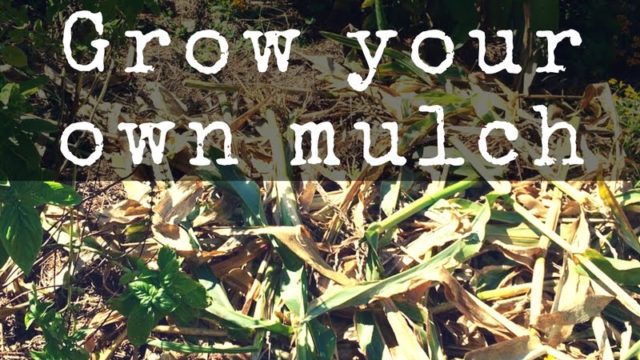- feeds soil life
- supports an increase in soil life diversity
- improves soil structure
- helps to retain moisture in the soil.
Regular composting and mulching does builds organic matter in the soil. You don’t need to dig it in – the thriving ecological system that exists (or is regenerating) below the surface will draw it down into the soil.
Mulch can be expensive to buy, and sourcing reliably seed-free mulch can also be challenging. I use organic sugar cane or local seed-free grass bales in the garden areas where I have salad greens and leafy annuals, but for the rest of it, I often rely on the ‘chop and drop’ method and living mulch. These help to reduce waste and also simplify work in the garden.
Chop and drop
Chop and drop mulching is a way to harness abundantly growing plants – ones which easily produce a lot of biomass and are happy to be trimmed. A good haircut actually can help the growth and form of many of these plants.
Here’s a couple of the things I use for this:
- finished vegetables
- pigeon pea
- QLD arrowroot
- comfrey
- lemongrass
- legume trees such as acacia and ice-cream bean
- sugarcane
- bamboo
 |
| The corn has finished so I have knocked it back and left it in situ. When it breaks down some more, I will plant a new crop through it. |
 |
| I’ve done similar things with the pumpkin vines when they are finished. You can see here the self-propagating sweet potato coming up through, and the new cutting of Cranberry Hibiscus. |
 |
| The great big juicy leaves of fast growing QLD Arrowroot (Canna edulis) make great chop and drop mulch in my subtropical garden. The recover quickly too. |
 |
| Comfrey produces an abundance of leaves that are easily digested by the soil and which add great nutrients. In the middle of the growing season, I regularly take all the leaves off comfrey plants for this purpose and they happily grow back again. |
Living Mulch
I allow a range of plants to cover the soil and these plants often have many uses (food, fibre, living mulch, habitat …) which makes them even better than plain mulch in my food forest and polycultural kitchen garden.
Some of the plants I use in this way in different parts of my garden are:
- clover
- pinto peanut
- sweet potato
- pumpkin
- Brazilian spinach (clumps)
- pepino
- mints



One thing I realised after doing the intro to permaculture course with you was that I need to grow a lot more plants for mulch. I have planted a row of lemon grass along one side of my front fence now and I also managed to get one large Canna in a pot from Northey St Nursery (they had it out the back so I was lucky:) which I divided into seven little plants. I've planted those out and I hope they'll grow too. We have also decided to invest in a mulcher to make better use of the material we already have growing, like the native ginger. Meg:)
Edible Landscapes Nursery at Northey Street City Farm, or you can order it online via Green Harvest. You can dry in the oven and grind in a coffee grinder to make your own arrowroot powder at home.
Vietnamese mint, brahmi, the great wonderful leaves of aibika all make great cut and drop as well as some plants mentioned by you Morag. I don't have much luck with Comfrey here in the north Qld tropics, especially over summer and in heavy constant rain the centre rots out as does parsley.
Like you I use sweet potato, pinto peanut, brazilian spinach, for growning green mulch, ceylon spinach along the ground also works well.
Your posts keep me inspired and grounded Morag, thank you.
What great timing.
Where would I pick up arrowroot in Brisbane?
And can you grind it up yrself or is thatnot possible at home?
Up here in Far north queensland I use lemongrass, and also cassava. The cassava can be used as shade for young seedlings. Comfrey does not like the wet season, but I have it in a pot, and then in the dry season, I separate out the plants and grow more. That way I dont lose the main plant.
Green Harvest. OK, I will check that out if i can't get over to Northey Street . Thank you!